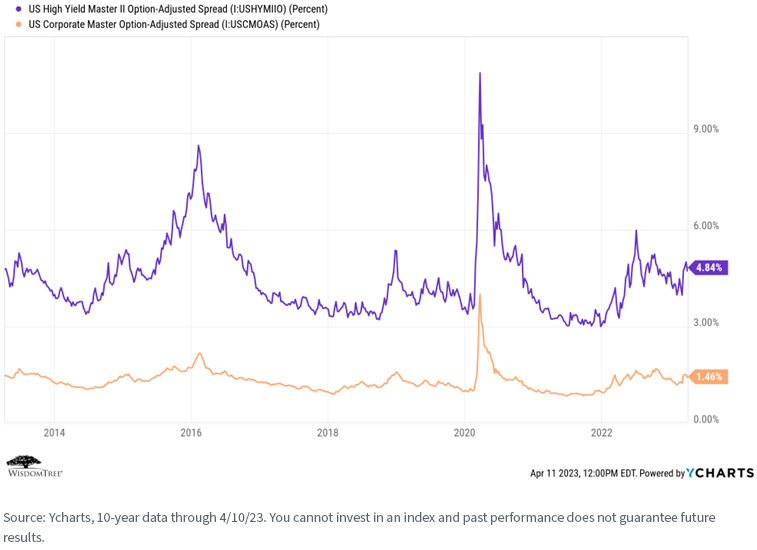The Q2 2023 WisdomTree Economic Market Outlook in 10 Charts or Less


“I just dropped in to see what condition my condition was in.”
(Kenny Rogers & The First Edition, 1967)
The first quarter of 2023 was volatile—economically, politically and marketwise. We saw dramatic interest rate movements, shifting opinions on the future of Fed policy, bank failures, governmental bailout programs, and a resurgence of large-cap growth and mega-tech stocks. A great deal of uncertainty remains as we begin Q2, but let’s try to break it down.
When reviewing the current state of the global economy and investment markets, we always recommend focusing on market signals and weeding out market noise. We believe the five primary economic and market signals that provide perspective on where we go from here are GDP growth, earnings, interest rates, inflation and central bank policy.
We continue to believe the U.S. economy will head into recession at some point this year, but we certainly are getting mixed signals from consumers, the Fed, and the bond and stock markets. So, let’s dive in.
GDP, Inflation and Central Bank Policy
Let’s start with a look at the yield curve (i.e., interest rates), specifically two closely watched spreads: the 10-year/2-year and the 10-year/3-month. In some cases, what we see is a level of inversion we haven’t witnessed since back in the 1960s.

We see that the 10s/2s has been inverted since roughly July 2022, while the 10s/3mo (historically the more accurate indicator of recessions, which are highlighted by the gray bars in the chart) inverted in October. Both are signaling a coming recession but, historically and importantly, with a time lag. Given how long and how steeply the curve has been inverted, we believe we are headed there, but perhaps not just yet given the relative strength of the labor and retail sales indicators.

While some argue that elevated inflation remains a primary concern in 2023, we believe it has peaked and will continue to fall through the year, especially if the Fed remains firm in its hawkish tone and narrative. The market currently is pricing in another 25 basis point (bp) rate hike at the May FOMC meeting, but also a pivot back toward a more accommodative stance as we move through the year. We note the headline CPI number is significantly impacted by housing and shelter data, which are subject to an approximately six-month reporting lag. CPI would look much lower if current or contemporaneous shelter data were used.
In fact, our belief in an impending recession later in 2023 is at least partly based on the idea that the Fed will remain hawkish for too long, driving economic growth downward.

With that as a backdrop, it is not surprising that the consensus estimate for annual GDP growth in 2023 is muted, or that many analysts believe we will enter a recession at some point during the year.

Outside the U.S., a slower-than-expected economic recovery in China following the end of its Zero Covid policies, combined with the ongoing Russia/Ukraine conflict, have worked to lower global economic forecasts as well.

Translation: A recession seems to be on the horizon. Positive economic news remains, especially in consumption and labor, but many indicators are declining.
While the Fed will be highly data dependent as we move through 2023, we believe we are at, or close to, the end of the rate hike cycle, at which point monetary policy will then enter into an extended pause. We may see a pivot toward a more accommodative monetary policy in the latter months of the year.
Our since-inception Senior Advisor Professor Jeremy Siegel also believes the Fed is misreading the current economic data and needs to pivot to rate cuts, sooner rather than later.
Earnings and Valuations
The consensus is that 2023 will witness a decline in corporate earnings as economic activity slows down and wages continue their upward trend, combining to put pressure on operating margins. This is a primary reason we believe the “quality tilt” in our products and Model Portfolios will continue to benefit us as we move through the year.

Outside the U.S., only Japan is expected to show positive earnings growth in 2023. Fundamental investors may find the relative valuations outside the U.S. to be quite attractive, especially if the dollar continues its downward trend.


Translation: We have entered a period of uncertainty with respect to the equity markets. All eyes will be on earnings as we move through the year—many expect a global earnings recession. Market valuations are in line with historical averages, with perhaps relative value available in Japan and Europe.
We saw a strong factor re-rotation toward large-cap growth and mega-tech stocks in Q1. If we are correct in our earnings and interest rate outlooks, we do not believe this trend will continue.
In addition, given the outperformance of large caps in Q1, small-cap and value stocks continue to represent a relative value opportunity going forward. We also believe dividend stocks will continue to be attractive as we move into increased market uncertainty.
We believe “quality” (i.e., companies with strong balance sheets, earnings and cash flows) will become increasingly important as margins and earnings get squeezed. Firms that can maintain their pricing power and dividends should outperform.
Interest Rates and Spreads
The yield curve remains an item of intense focus these days. We discussed the level and shape of the curve above, but what about credit spreads?
Credit spreads have risen but remain in line with historical levels. This, combined with positive real rates across the maturity spectrum translates into “there is income back in fixed income.”
Corporate balance sheets are in decent shape, so coupons should be safe. We increased the duration of our strategic fixed income model several months ago but remain short duration relative to the Bloomberg Aggregate index, as well as having an over-weight allocation to quality credit.
We believe there is relative value in high-yield bonds and, given the shape of the yield curve, we still like floating rate Treasuries.


Translation: We increased the duration within our fixed income portfolios a few months ago but remain short duration and have an over-weight allocation to quality credit relative to the Bloomberg Aggregate index. Floating rate Treasuries remain a high conviction trade for us, and we believe quality-oriented high yield is an attractive relative value trade.
Summary
When focusing on what we believe are the primary economic and market signals, the “condition our condition is in” is uncertain. Economic growth is slowing, and we are probably headed into a recession. Earnings are expected to fall. The labor market and consumer spending remain solid, though both are perhaps showing signs of slowing down.
Combined with sticky inflation, the ongoing Russia/Ukraine conflict, concerns over systemic banking risk following several notable failures, and a Fed that is in a pickle—trying to balance inflation with systemic liquidity risk concerns—these are volatile and uncertain times.
To summarize our primary investment themes and views for 2023:
- There is income back in fixed income. We believe there is relative value in high yield, and we continue to like U.S. floating rate Treasuries.
- Despite the performances in Q1, our continued theme for the 2020s is a decade led by value and dividend stocks.
- Quality is an increasingly important risk factor as investors refocus on fundamentals during uncertain times.
- U.S. small-cap stocks are presenting attractive valuation plays.
- Higher dividends, lower valuations and the possibility of a continued decline in the dollar suggest that U.S. investors should pay more attention to non-U.S. investment opportunities.
- Active management and intelligent risk factor tilts should be rewarded versus passive management (i.e., cap-weighted beta).
That said, as strategic investors, we continue to suggest focusing on a longer-term time horizon and the construction of all-weather portfolios, diversified at both the asset class and risk factor levels.
For definitions of Indexes/terms in the charts above, please visit the glossary.
Related Content
Q2 2023 WisdomTree Economic & Investments Chart Book

